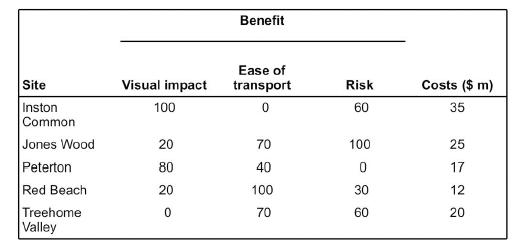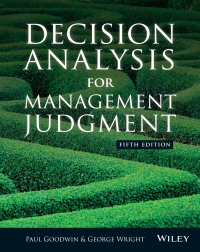(5) A local authority has to decide on the location of a new waste-disposal facility and five...
Question:
(5) A local authority has to decide on the location of a new waste-disposal facility and five sites are currently being considered: Inston Common, Jones Wood, Peterton, Red Beach and Treehome Valley. In order to help them choose between the sites, the managers involved in the decision arranged for a decision analyst to attend one of their meetings. He first got the managers to consider the factors which they thought were relevant to the decision and, after some debate, four factors were identified:
(i) The visual impact of the site on the local scenery (for example, a site at Treehome Valley would be visible from a nearby beauty spot).
(ii) The ease with which waste could be transported to the site (for example, Red Beach is only 2 miles from the main town in the area and is close to a main highway, while Inston Common is in a remote spot and its use would lead to a major increase in the volume of transport using the minor roads in the area).
(iii) The risk that the use of the site would lead to contamination of the local environment (e.g., because of leakages of chemicals into watercourses).
(iv) The cost of developing the site.
The decision analyst then asked the managers to assign scores to the sites to show how well they performed on each of the first three attributes. The scores they eventually agreed are shown below, together with the estimated cost of developing each site. Note that 0 represents the worst and 100 the best score on an attribute. In the case of risk, therefore, a score of 100 means that a site is the least risky.

The decision analyst then asked the managers to imagine a site which had the worst visual impact, the most difficult transport requirements and the highest level of risk. He then asked them if they had a chance of switching from this site to one which had just one of the benefits at its best value, which would they choose? The managers agreed that they would move to a site offering the least risk of contamination. A move to a site with the best visual impact was considered to be 80% as preferable as this, while a move to one with the most convenient transport facilities was 70% as preferable.
(a) Can we conclude from the values which were assigned to the different sites for visual impact that, in terms of visual impact, the Inston Common site is five times preferable to Red Beach? If not, what can we infer from the figures?
(b) An alternative way of allocating weights to the three benefit attributes would have involved asking the managers to allocate a score reflecting the importance of each attribute. For example, they might have judged that risk was five times more important and visual impact three times more important than ease of transport, so that weights of 5, 3 and 1 would have been attached to the attributes. What are the dangers of this approach?
(c) Assuming that mutual preference independence exists between the attributes, determine the value of aggregate benefits for each site.
(d) Plot the aggregate benefits and costs of each site on a graph and hence identify the sites which lie on the efficient frontier.
(e) Although a weight of 80 was finally agreed for visual impact, this was only after much debate and some managers still felt that a weight of 65 should have been used while others thought that 95 would have been more appropriate. Perform a sensitivity analysis on the weight assigned to visual impact to examine its effect on the aggregate benefits of the sites and interpret your results.
Step by Step Answer:

Decision Analysis For Management Judgment
ISBN: 9781118740736,9781118889251
5th Edition
Authors: Paul Goodwin , George Wright




